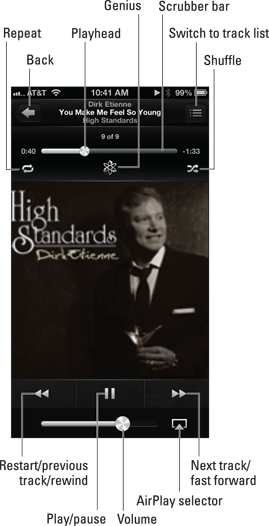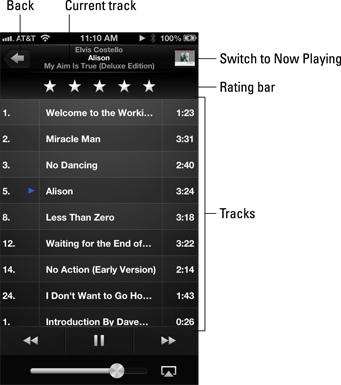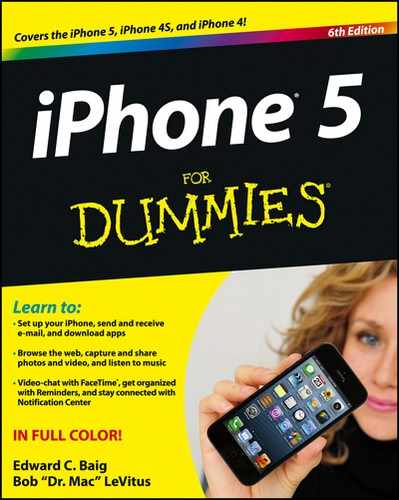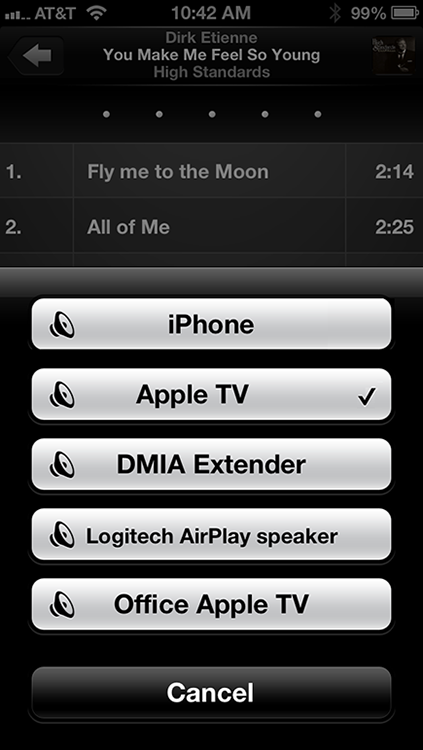Taking Control of Your Tunes
Now that you have the basics down, take a look at some other things you can do with the Music app.
Go with the (Cover) Flow
Finding tracks by playlist, artist, or song is cool, but finding them with Cover Flow is even cooler. Cover Flow lets you browse your music collection by its album artwork. To use Cover Flow, turn your iPhone sideways (long edges parallel to the ground) and Cover Flow will fill the screen, as shown in Figure 8-3.
Flipping through your cover art in Cover Flow is simple. All you have to do is drag or flick your finger left or right on the screen and the covers go flying by. Flick or drag quickly and the covers whiz past; flick or drag slowly and the covers move leisurely. Or tap a particular cover on the left or right of the current (centered) cover and that cover jumps to the center.

Figure 8-3: Go with the Cover Flow.
Try it — you’ll like it! Here’s how to put Cover Flow to work for you:
![]() To see tracks (songs) on an album: Tap the cover when it’s centered or tap the info button (the little i) in the lower-right corner of the screen. The track list appears.
To see tracks (songs) on an album: Tap the cover when it’s centered or tap the info button (the little i) in the lower-right corner of the screen. The track list appears.
![]() To play a track: Tap the track name in the list. If the list is long, scroll by dragging or flicking up and down on it.
To play a track: Tap the track name in the list. If the list is long, scroll by dragging or flicking up and down on it.
![]() To go back to Cover Flow: Tap the title bar at the top of the track list or tap the little i button again.
To go back to Cover Flow: Tap the title bar at the top of the track list or tap the little i button again.
![]() To play or pause the current song: Tap the play/pause button in the lower-left corner.
To play or pause the current song: Tap the play/pause button in the lower-left corner.
And that, friends, is all there is to the Music app’s cool Cover Flow.
Flow’s not here right now
As you saw earlier in this chapter, when you hold your iPhone vertically (the short edges are parallel to the ground) and tap the Playlists, Artists, or Songs icon, you see a list rather than Cover Flow.
Along the same lines, when you’re listening to music, the controls you see are different depending on which way you hold your iPhone. When you hold your iPhone vertically, as shown in Figure 8-4, you see controls that don’t appear when you hold your iPhone sideways. Furthermore, the controls you see when viewing the Playlists, Artists, or Songs lists are slightly different from the controls you see when a song is playing.

Figure 8-4: Hold your iPhone vertically when you play a track and you see these controls.
Here’s how to use the controls that appear when the iPhone is vertical:
![]() Back button: Tap to return to whichever list you used last — Playlists, Artists, or Songs.
Back button: Tap to return to whichever list you used last — Playlists, Artists, or Songs.
![]() Switch to track list button: Tap to switch to a list of tracks.
Switch to track list button: Tap to switch to a list of tracks.
![]() Repeat button: Tap once to repeat songs in the current album or list. The button turns blue. Tap the repeat button again to play the current song repeatedly; in this mode, the blue button displays the number 1. Tap the button again to turn off this feature. The button goes back to its original gray color.
Repeat button: Tap once to repeat songs in the current album or list. The button turns blue. Tap the repeat button again to play the current song repeatedly; in this mode, the blue button displays the number 1. Tap the button again to turn off this feature. The button goes back to its original gray color.
 If you don’t see the repeat button, the scrubber bar, and the shuffle button, tap the album cover once to make them appear.
If you don’t see the repeat button, the scrubber bar, and the shuffle button, tap the album cover once to make them appear.
![]() Scrubber bar: Drag the little dot (the playhead) along the scrubber bar to skip to any point within the song.
Scrubber bar: Drag the little dot (the playhead) along the scrubber bar to skip to any point within the song.
![]() Genius button: Tap once and a Genius playlist appears with 25 songs that iTunes thinks will go great with the song that’s playing.
Genius button: Tap once and a Genius playlist appears with 25 songs that iTunes thinks will go great with the song that’s playing.
 The less popular the song, artist, or genre, the more likely the so-called Genius will choke on it. When that happens, you see an alert asking you to try again because this song doesn’t have enough related songs to create a Genius playlist.
The less popular the song, artist, or genre, the more likely the so-called Genius will choke on it. When that happens, you see an alert asking you to try again because this song doesn’t have enough related songs to create a Genius playlist.
At the top of the Genius playlist, you find three buttons:
• New: Select a different song to use as the basis for a Genius playlist.
• Refresh: See a list of 25 other songs that go great with the song you’re listening to, at least according to iTunes.
• Save: Save this Genius playlist so that you can listen to it whenever you like.
 If you like the Genius feature, you can also create a new Genius playlist by tapping the Playlists icon at the bottom of the screen and then tapping Genius, which is the first item in the list of playlists.
If you like the Genius feature, you can also create a new Genius playlist by tapping the Playlists icon at the bottom of the screen and then tapping Genius, which is the first item in the list of playlists.
![]() Shuffle button: Tap once to shuffle songs and play them in random order. The button turns blue when shuffling is enabled. Tap it again to play songs in order again. The button goes back to its original color — gray.
Shuffle button: Tap once to shuffle songs and play them in random order. The button turns blue when shuffling is enabled. Tap it again to play songs in order again. The button goes back to its original color — gray.
 You can also shuffle tracks in any list of songs — such as playlists or albums — by tapping the word Shuffle, which appears at the top of the list. Regardless of whether the shuffle button has been tapped, this technique always plays songs in that list in random order. And, as you see later in this chapter, the Shake to Shuffle option, when enabled, lets you shake your iPhone from side-to-side to shuffle and play a different song at random.
You can also shuffle tracks in any list of songs — such as playlists or albums — by tapping the word Shuffle, which appears at the top of the list. Regardless of whether the shuffle button has been tapped, this technique always plays songs in that list in random order. And, as you see later in this chapter, the Shake to Shuffle option, when enabled, lets you shake your iPhone from side-to-side to shuffle and play a different song at random.
![]() Restart/previous track/rewind button: Tap once to go to the beginning of the track. Tap this button twice to go to the start of the preceding track in the list. Touch and hold this button to rewind the song at double speed.
Restart/previous track/rewind button: Tap once to go to the beginning of the track. Tap this button twice to go to the start of the preceding track in the list. Touch and hold this button to rewind the song at double speed.
![]() Play/pause button: Tap to play or pause the song.
Play/pause button: Tap to play or pause the song.
![]() Next track/fast forward button: Tap to skip to the next track in the list. Touch and hold down this button to fast-forward through the song at double speed.
Next track/fast forward button: Tap to skip to the next track in the list. Touch and hold down this button to fast-forward through the song at double speed.
![]() AirPlay selector icon: You may or may not see the AirPlay Selector icon on your screen (it’s visible in Figure 8-4). AirPlay lets you stream content wirelessly over Wi-Fi from your iPhone to any AirPlay-enabled device. Check out the AirPlay sidebar for the details.
AirPlay selector icon: You may or may not see the AirPlay Selector icon on your screen (it’s visible in Figure 8-4). AirPlay lets you stream content wirelessly over Wi-Fi from your iPhone to any AirPlay-enabled device. Check out the AirPlay sidebar for the details.
![]() Volume control: Drag the little dot left or right to reduce or increase the volume level.
Volume control: Drag the little dot left or right to reduce or increase the volume level.
When you tap the switch to track list button, the iPhone screen and the controls change, as shown in Figure 8-5.

Figure 8-5: Tap the switch to track list button and these controls appear.
Here’s how to use those controls:
![]() Switch to Now Playing button: Tap to switch to the Now Playing screen for the current track (refer to Figure 8-4).
Switch to Now Playing button: Tap to switch to the Now Playing screen for the current track (refer to Figure 8-4).
![]() Rating bar: Drag across the rating bar to rate the current track using zero to five stars. The track shown in Figure 8-5 has a five-star rating.
Rating bar: Drag across the rating bar to rate the current track using zero to five stars. The track shown in Figure 8-5 has a five-star rating.
The tracks are the songs in the current list (Albums, Playlists, or Artists, for example). The current track indicator shows you which song is now playing (or paused). Tap any song in a track list to play it.
And that, gentle reader, is all you need to know to enjoy listening to music (and podcasts and audiobooks) on your iPhone.


